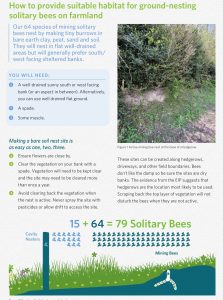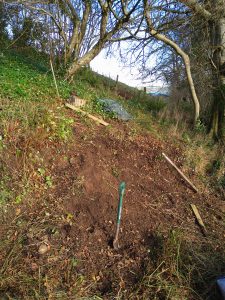Protecting Farmland Pollinators
In 2019, the National Biodiversity Data Centre received funding through the Department of Agricultural, Food and the Marine for a five-year European Innovation Partnership (EIP) project called ‘Protecting Farmland Pollinators’.
By working closely with a group of 40 farmers chosen to reflect differing farm types and intensity levels, the project identified actions that allow biodiversity to coexist within a productive farming system. The project aims to help farmers understand how pollinator-friendly their farm is through a whole-farm pollinator scoring system. Through evidence-based recommendations, it also provides advice on how to provide habitats that will offer food, safety, and shelter on their farms for pollinators such as wild bees and hoverflies, and other biodiversity.
Why are pollinators important on farms?
Pollinators are important to farmers who grow insect pollinated crops, fruits and vegetables; to our economy; to marketing our produce abroad; and to the health of our environment. However, farmland has experienced wide-scale loss of wild pollinators over the last fifty years. In Ireland, one third of our 100 wild bee species are threatened with extinction.
How to create nesting habitats

Over the coming year, the ‘Protecting Farmland Pollinators’ project will publish a series of evidence-based action sheets on how to best support pollinators on farmland. The first of these is now available: How to create solitary bee nest sites on your farm.
This sheet has clear step-by-step instructions on how to create nesting sites for ground-nesting solitary bees and above-ground cavity nesting bees. It includes practical advice such as the tools you need, and tips from farmers who have already created nesting habitats on their own farms.
While the action sheet was developed for farmland, the learnings will apply across all sectors and be of relevance to anyone interested in the most effective way to create nesting habitat for solitary bees.
As part of the EIP project, farmers created over 300 nest sites for mining solitary bees and 130 sites for cavity nesting solitary bees. Proving the learnings of the EIP project, and with a lovely example of how easy it is to support solitary bees, Geoff Newell at at Jubilee Farm in Northern Ireland recently reached out to tell us about the nesting habitats he has created for pollinators
Geoff Newell on creating pollinator nesting habitat at Jubilee Farm, Antrim

Jubilee Farm is Northern Ireland’s first community-owned farm, run to organic principles, using no pesticides or artificial fertiliser. We aim to demonstrate that it is possible to manage productive agricultural land in a manner which is beneficial for wildlife.
One of our first tasks this year was to remove a patch of invasive Pheasantberry from one area of the farm. We did this manually, by digging up the roots, and without using chemicals. In doing this, we created a few bare patches of south-east facing bank. Rather than letting these areas vegetate over again, we kept them clear, with the hope of creating solitary bee nesting habitat. Often it can take a few years for wildlife to find new habitat like this, but amazingly, within 3 months, we started seeing solitary bees digging nesting holes!
So far, 3 species have been recorded, including the black and grey striped Ashy Mining Bee. There are lots of wildflowers near this bank, which most people would consider “weeds”, especially Dandelions. These have been vital for these hard-working little bees, gathering nectar and pollen to provision their offspring, which will emerge next year.
Geoff Newell, Wildlife and Wellbeing Project Officer, Jubilee Farm
Find Out More:
Protecting Farmland Pollinators project homepage – National Biodiversity Data Centre
Providing Nesting Places for Pollinators on Your Farm » All-Ireland Pollinator Plan
